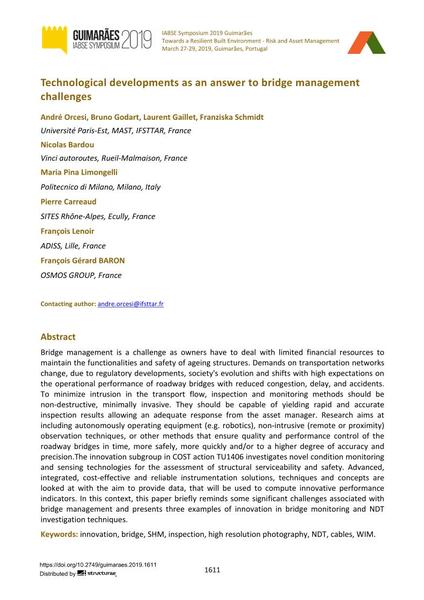Technological developments as an answer to bridge management challenges

|
|
|||||||||||
Détails bibliographiques
| Auteur(s): |
Andre Orcesi
(Université Paris-Est, MAST, IFSTTAR, France)
Bruno Godart (Université Paris-Est, MAST, IFSTTAR, France) Laurent Gaillet (Université Paris-Est, MAST, IFSTTAR, France) Franziska Schmidt Nicolas Bardou (Vinci autoroutes, Rueil-Malmaison, France) Maria Pina Limongelli (Politecnico di Milano, Milano, Italy) Pierre Carreaud (SITES Rhône-Alpes, Ecully, France) François Lenoir (ADISS, Lille, France) François Gérard Baron (OSMOS GROUP, France) |
||||
|---|---|---|---|---|---|
| Médium: | papier de conférence | ||||
| Langue(s): | anglais | ||||
| Conférence: | IABSE Symposium: Towards a Resilient Built Environment Risk and Asset Management, Guimarães, Portugal, 27-29 March 2019 | ||||
| Publié dans: | IABSE Symposium Guimarães 2019 | ||||
|
|||||
| Page(s): | 1611-1618 | ||||
| Nombre total de pages (du PDF): | 8 | ||||
| DOI: | 10.2749/guimaraes.2019.1611 | ||||
| Abstrait: |
Bridge management is a challenge as owners have to deal with limited financial resources to maintain the functionalities and safety of ageing structures. Demands on transportation networks change, due to regulatory developments, society's evolution and shifts with high expectations on the operational performance of roadway bridges with reduced congestion, delay, and accidents. To minimize intrusion in the transport flow, inspection and monitoring methods should be non-destructive, minimally invasive. They should be capable of yielding rapid and accurate inspection results allowing an adequate response from the asset manager. Research aims at including autonomously operating equipment (e.g. robotics), non-intrusive (remote or proximity) observation techniques, or other methods that ensure quality and performance control of the roadway bridges in time, more safely, more quickly and/or to a higher degree of accuracy and precision.The innovation subgroup in COST action TU1406 investigates novel condition monitoring and sensing technologies for the assessment of structural serviceability and safety. Advanced, integrated, cost-effective and reliable instrumentation solutions, techniques and concepts are looked at with the aim to provide data, that will be used to compute innovative performance indicators. In this context, this paper briefly reminds some significant challenges associated with bridge management and presents three examples of innovation in bridge monitoring and NDT investigation techniques. |
||||
| Mots-clé: |
pont câbles innovation
|
||||
